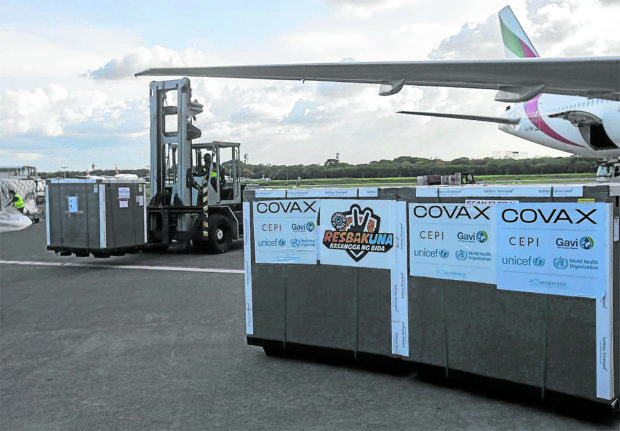
MUCH AWAITED Two million doses of AstraZeneca vaccines from the COVAX facility arrive at Ninoy Aquino International Airport on Friday, boosting the government’s vaccination program. (Photo by RICHARD A. REYES / Philippine Daily Inquirer)
MANILA, Philippines — Local governments should now administer as a first jab some 6,000 remaining AstraZeneca doses that are due to expire by the end of July, the National Vaccination Operations Center (NVOC) said on Sunday.
According to the NVOC, the doses — which came from the 2 million AstraZeneca donation of the COVAX global vaccine pool back in May—remain unused since these are reserved as a second jab.
“It’s also possible that [the local governments] have just not yet reported [to the NVOC] if these were already injected. But we will advise them to jab these as first dose already and just get their second doses from the incoming [supplies],” Health Undersecretary Myrna Cabotaje, who heads the NVOC, said in a Viber message.
Secretary Carlito Galvez Jr., vaccine manager and National Task Force Against COVID-19 chief implementer, said in a statement: “There is no issue on vaccines that have a shorter shelf life because we can administer them immediately. We have no problem with that.”
The shelf life of the donated AstraZeneca doses, which usually last a month or two, has previously concerned health advocates, who had been worried about vaccine wastage due to the pace of the rollout which began in March.
But Galvez said the vaccination pace has picked up to the present daily average of 250,000 or about half the government’s target of 500,000 doses daily.
The NVOC has also started distributing to its local health centers the Japanese donation of 1.1 million AstraZeneca doses which arrived last Thursday and the 2 million AstraZeneca doses from COVAX which arrived on Friday.
The expiration date of some of these jabs is Aug. 31, and the others, on Sept. 30 and on Oct. 31, Cabotaje said.
Meanwhile, the OCTA Research Group said in a report to be released today that there has been a “marked decrease” in the COVID-19 fatality rate in the National Capital Region (NCR), especially among the senior population.
OCTA said the overall fatality rate in the capital region went down from 1.06 percent in the first quarter this year to 0.78 in the month of June up to July 6.
Among the senior population, deaths were reduced from 5.87 percent to 4.29 percent in that six-month period—a 27 percent decrease, OCTA said.
The fatality rate declined by 25 percent in the age group 50-59, and by 60 percent in the age group 40-49, but was steady at 0.13 percent in the age group 18-39.
Among children and adolescents, however, the fatality rate rose from 0.07 percent to 0.20 percent or “one out of 500 cases,” OCTA said.
Still, the research group noted that the decrease in deaths is largely attributed to better management of the pandemic in the country compared with last year, at its height.
OCTA said NCR’s fatality rate in 2020 was 2.32 percent, which meant that “more than 2 out of 100 [newly reported] cases were dying due to COVID,” the group said.
The capital region at the time was deemed the epicenter of the pandemic in the country.
The group also credited the vaccine rollout as a factor in the reduced fatalities, especially among people age 40 and above.
Virus case update
The Department of Health (DOH) on Sunday reported 5,916 more COVID-19 cases, which brought the total case count to 1,473,025.
There are 49,701 active cases in the latest case bulletin of the DOH, of which 89.3 percent are mild, 5 percent are asymptomatic, 1.7 percent are moderate, 1.5 percent are critical, and 2.4 percent are severe.
The department said 6,127 more people have recovered from the disease, bringing the total recoveries to 1,397,403.
On the other hand, 105 more people succumbed to COVID-19, including 53 who were previously tagged as recoveries, bringing the coronavirus death toll to 25,921.
Of the 47,070 people tested on Friday, the DOH said 11.4 percent were confirmed to have the coronavirus.
Three laboratories, however, did not submit their test results to the department.